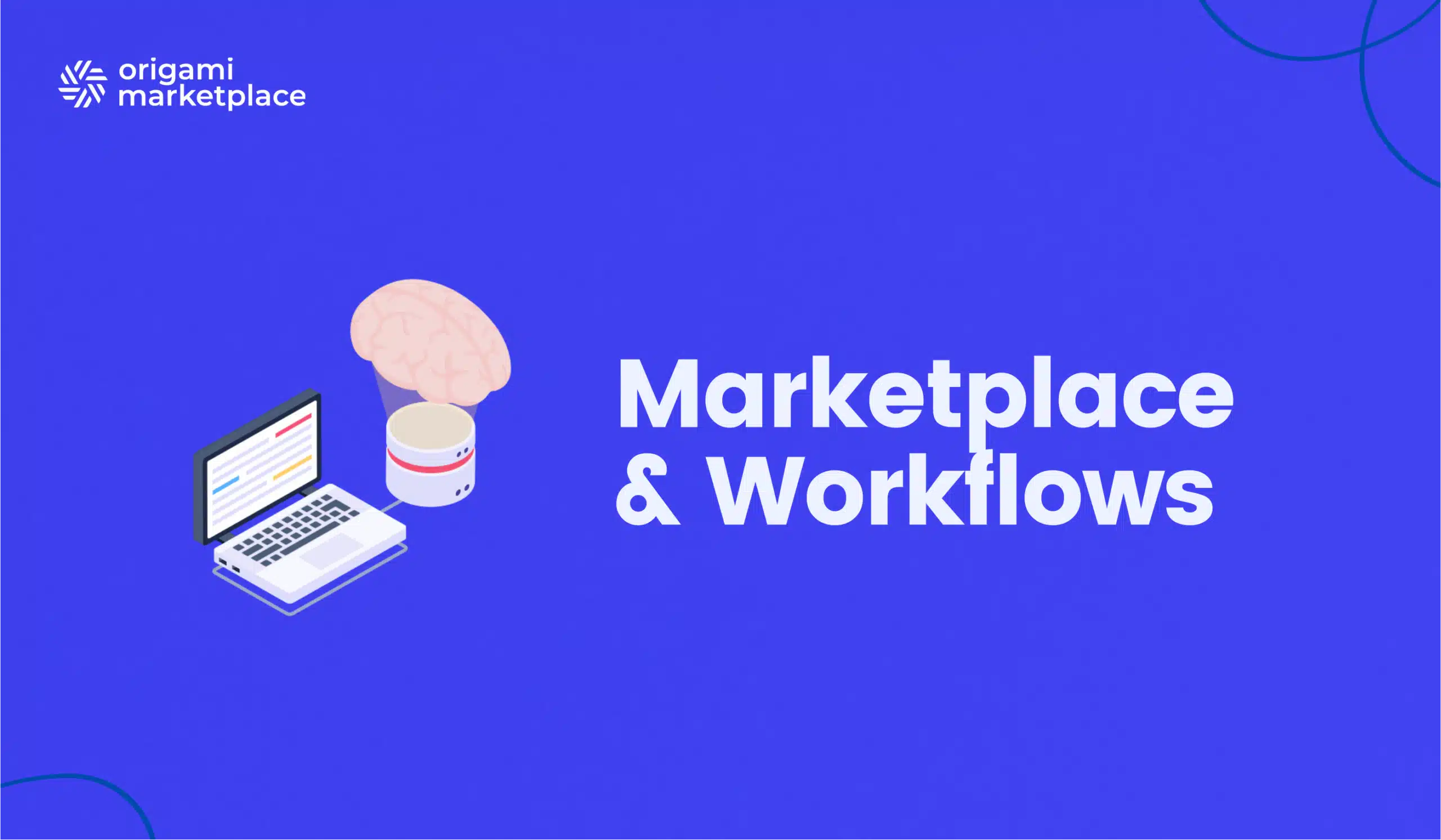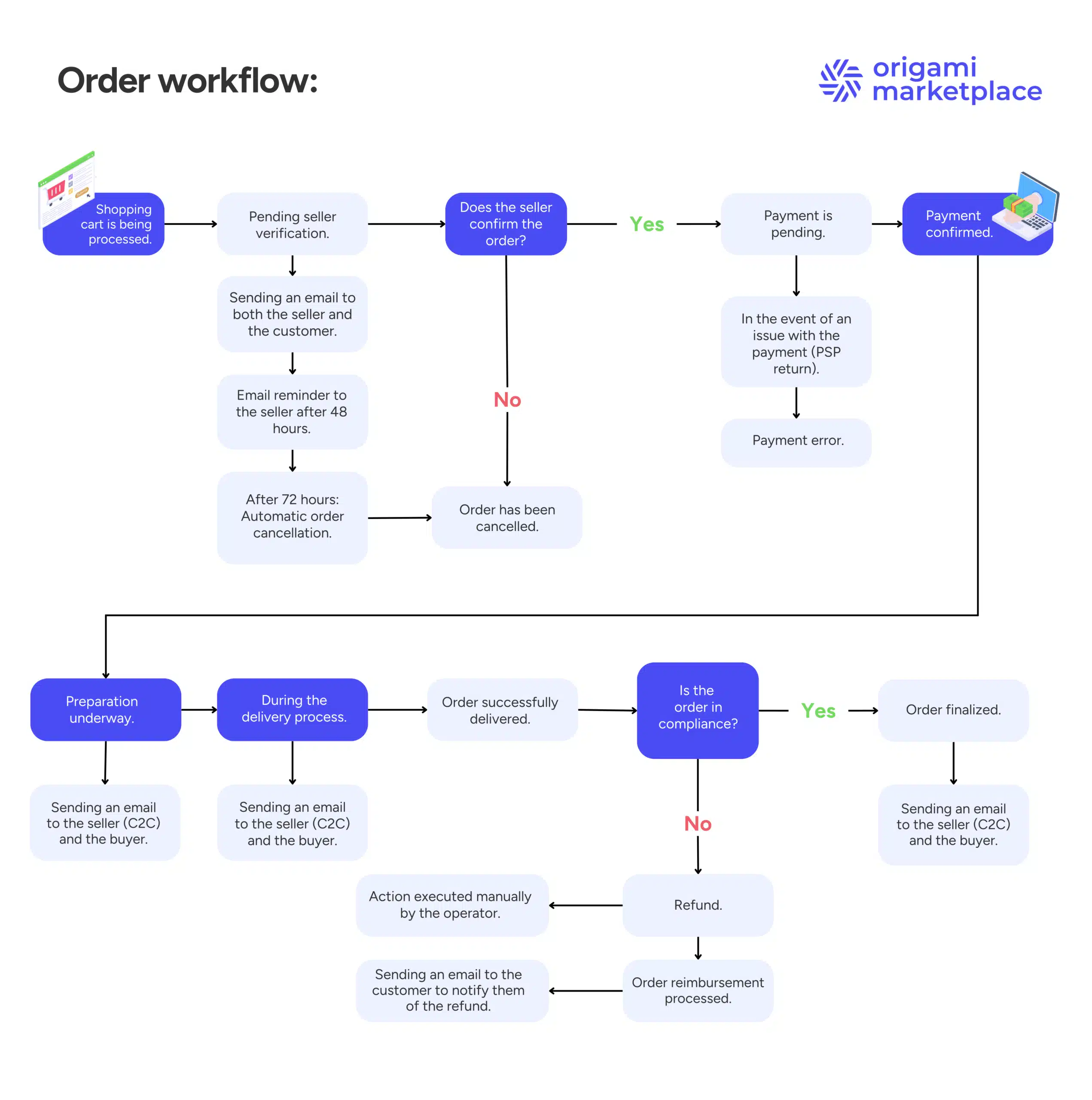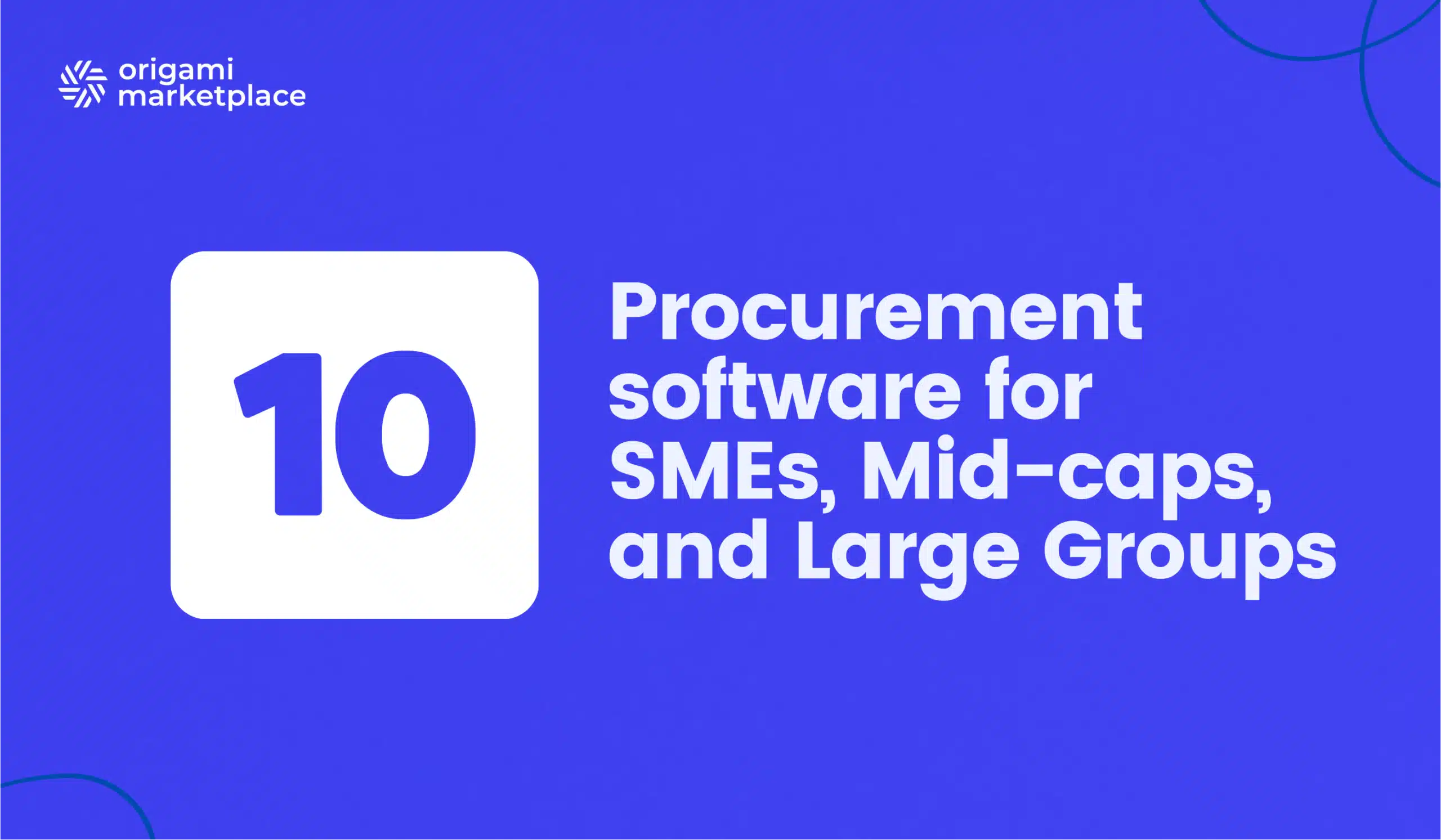Everything you need to know about marketplace workflows
- Arnaud
- 6 minutes reading

When it comes to efficiently managing and automating a marketplace, workflows are a crucial component. They simplify process management, reduce errors, and enable you to focus on higher-value tasks.
But what exactly is a workflow? How can you use it to optimize your platform’s operations—whether in B2B, B2C, or C2C models? What are the common questions operators have on this subject? In this article, we’ll clarify these points and highlight the advantages of a high-performance workflow engine, like the one offered by Origami Marketplace.
👋 No time to read the whole article? Find the summary here.
1. What is a workflow?
A workflow is a sequence of steps and rules applied to a process, from its initiation through to its completion. It provides a structured way to organize and execute repetitive or complex tasks for the operator, ensuring greater efficiency and smoother operations.
Examples:
- Order validation workflow: For each purchase, it allows you to manage the entire order lifecycle, including payment verification, sending confirmations, and updating inventory.
- Customer support workflow: A support request is automatically assigned to an agent, processed according to predefined rules, and the customer is notified once the issue is resolved.
2. What is a workflow engine?
A workflow engine is a software tool that allows you to create, manage, and automate the various steps of a process. It ensures compliance with established rules, sequences actions based on predefined logic, and provides clear oversight of every operation. The workflow engine is, in a way, the brain of the marketplace.
Key functions of a workflow engine for a marketplace:
- Custom process creation: Define your own rules according to your business objectives.
- Automated notifications: Send emails, SMS messages, or internal alerts without any manual intervention.
- Real-time operational tracking: Quickly identify bottlenecks, optimize resources, and anticipate future constraints.
- Analysis and optimization: Measure performance, pinpoint areas for improvement, and adjust your workflows for optimal results.
Download our free marketplace specifications template.
Here you will find all the essential features to succeed in your multi-vendor marketplace. This model provides a simple backlog to guide you through each step of your project.

3. Which workflows should I create for my marketplace?
The possibilities are as varied as your platform’s needs. Whether you operate in B2B, B2C, or C2C environments, here are some examples:
Workflows for vendor management:
- Vendor onboarding: Document collection and verification, account setup.
- Payment management: Automated payment calculations, triggering transfers once orders are validated.
Workflows for buyers:
- Order validation: Payment verification, confirmation of product or service availability, and sending summary emails.
- Return management: Rules for return authorization, vendor notifications, and issuing refunds.
- Abandoned cart reminders: Sending personalized incentives to encourage order completion.
Communication workflows:
- Automated moderation: Define your own criteria and set up an automated moderation system on your platform, freeing you from potentially time-consuming manual tasks.”
- Abandoned cart reminders: Sending personalized incentives to encourage order completion.
- Guided resolution: Suggested template responses, escalation of complex issues to a higher support tier.
Below, you’ll find the full sequence of the order workflow offered to operators using Origami Marketplace. This workflow is fully customizable and can be adapted to the specific needs of any marketplace, ensuring it perfectly meets your operational requirements.

Looking for more real-world examples?
- Product inventory management workflow: Update stock levels and send automatic alerts when items run out of stock.
- Dispute management workflow: Collect information, communicate with stakeholders, and track and resolve conflicts in a structured manner.
- Review workflow: An operator can define the lifecycle of a review, and may choose not to display it until an internal team has confirmed that it complies with the platform’s general usage guidelines, for example.
4. Why are workflows essential for a marketplace?
- Automation of repetitive tasks: Less manual intervention means more time for strategic analysis and innovation.
- Reduced errors: Systematic application of predefined rules minimizes execution issues.
- Enhanced user experience: Speed, transparency, and consistency improve satisfaction for both sellers and buyers.
- Tracking and optimization: Clear, actionable data for continually adjusting and improving processes.
5. Marketplace operators’ common questions about workflows
Before adopting a workflow engine, operators often ask key questions:
- Implementation complexity: Can we customize it quickly without advanced technical skills?
- Customization and scalability: Can I easily adjust the rules if my needs evolve, my business grows, or I expand into new markets?
- Security and compliance: Does the engine meet data protection and transaction security standards?
- Costs and return on investment: What tangible benefits can I expect in terms of time savings, cost reductions, customer experience, and competitive differentiation?
Yes, the answer to all these questions is positive, and Antoine will certainly put your mind at ease with the explanations below.
Don’t worry about the complexity of setting up workflows. With Origami Marketplace, you receive personalized support. Our team of experts, including myself, will guide you step-by-step through the initial setup, basic workflow configuration, and the creation of custom processes tailored to your business’s unique requirements. With this assistance, you’ll save time, secure your operations, and ensure optimal management of your marketplace right from the start.

Antoine Mantel
→ Talk to our solutions expert
6. The Origami Marketplace advantage: A powerful and flexible workflow engine
Origami Marketplace currently offers one of the most powerful workflow engines on the market. With its scalable architecture, intuitive interface, and extensive integration capabilities, it can adapt to B2B, B2C, or C2C models. It enables:
- Simplified multi-vendor management: Streamlined onboarding, centralized order tracking, and automated product updates.
- Significant time savings: Fewer manual tasks, fewer errors, and greater responsiveness to customer and seller inquiries.
- Enhanced quality of service: Smooth, transparent processes and clear communication with all stakeholders.
- A clear competitive edge: As marketplaces grow more complex, having an advanced workflow engine becomes a true differentiator.
- A scalable workflow engine: Every specific development request made by a user automatically benefits all marketplaces that have adopted our solution.
Workflows are an essential pillar of a successful marketplace. They ensure smooth operations, reduce the risk of errors, and significantly improve the overall experience for all platform stakeholders. By adopting a high-performance workflow engine, such as the one from Origami Marketplace with its extensive range of features, you give yourself every advantage to streamline your processes, save time, prevent unnecessary cancellations, and deliver impeccable service.
Whether you’re just launching your marketplace or looking to professionalize your operations, integrating robust, scalable workflows will help you sustainably support your growth. Start exploring these solutions today and equip your platform with the ability to continuously adapt to an ever-changing market.
Key Takeaways:
- Workflows: Sequences of steps and rules that automate your processes, from order validation to customer support.
- Workflow engine: A software tool that makes it easy to create, manage, and run customized workflows.
- Benefits:
- Automation of repetitive Tasks for time savings.
- Reduced errors through predefined rules.
- Improved user experience thanks to fast and consistent actions.
- Continuous monitoring and optimization of performance.
- Workflow examples: Vendor onboarding, order validation, returns management, customer ticket handling, and promotional campaigns.
- Origami Marketplace advantage: A powerful and flexible workflow engine designed for B2B, B2C, and C2C platforms, providing time savings, higher service quality, and a competitive edge.
Discover how Origami Marketplace’s API and partner network can transform your business, regardless of its size, with its innovative marketplace-based solution.


